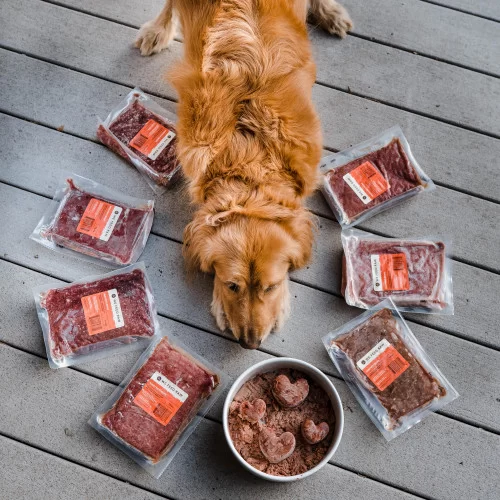The Raw vs Cooked Dog Food Debate: Which Is Best for Your Furry Friend?
As a dog owner, I often find myself reflecting on one of the most common debates in the world of pet care: Should I feed my dog raw food or cooked food? This question isn’t as simple as it might seem, and many pet owners, like myself, struggle with whether raw or cooked food is the best choice for our dogs. In this article, I’ll take you on a journey through the raw vs cooked dog food debate, exploring the benefits, risks, and everything you need to know to make an informed decision for your pet's health.
The Case for Raw Dog Food
Raw food diets for dogs, often called "BARF" (Biologically Appropriate Raw Food) or "Prey Model" diets, have gained significant popularity over the years. Proponents of raw dog food believe that it’s the most natural and beneficial way to feed our pets. The idea is that feeding your dog raw, unprocessed food mimics what their ancestors ate in the wild. This means that a raw diet typically includes raw meat, bones, organs, fruits, and vegetables. As I researched this option, I discovered many compelling arguments supporting raw feeding.
For one, raw food diets are often touted for promoting healthier coats, improved digestion, and stronger immune systems. One dog owner I spoke with, Sarah, mentioned how her dog’s chronic skin issues cleared up after switching to a raw food diet. She explained that the addition of omega-3 fatty acids found in raw fish and meat helped reduce inflammation and support her dog’s skin health. I couldn’t help but be intrigued by the potential benefits of feeding dogs raw food, especially after hearing such positive results.
Potential Benefits of Raw Dog Food
Some of the most commonly cited benefits of raw dog food include:
- Improved digestion: Raw food is easier for some dogs to digest compared to cooked food, as it retains more nutrients.
- Shinier coat and healthier skin: Raw diets, especially those rich in fatty acids, contribute to a glossy coat and healthy skin.
- Better dental health: Chewing raw bones can help clean your dog’s teeth naturally, reducing plaque and tartar buildup.
- Increased energy levels: Many dog owners report that their pets seem more energetic and active on a raw food diet.
The Risks of Raw Dog Food
However, feeding your dog raw food is not without its risks. There are potential concerns with bacterial contamination, such as salmonella or E. coli, which could make both dogs and humans sick. In fact, when I first considered transitioning my dog to raw food, I was hesitant due to the risks of bacterial exposure. I spoke with my veterinarian, who reminded me that proper handling, sourcing from reputable suppliers, and ensuring the food is stored at the right temperature are key to mitigating these risks.
Another potential risk involves the balance of nutrients. Preparing a raw food diet requires careful planning to ensure your dog is getting the right vitamins and minerals. An unbalanced raw food diet could lead to nutritional deficiencies, which could negatively impact your dog’s health. That’s why it’s important to consult a professional or a veterinary nutritionist before switching to a raw food regimen.
The Case for Cooked Dog Food
On the other side of the debate, cooked dog food has long been a popular option for pet owners. Cooked food, often served in kibble or canned form, offers convenience and ensures that the food is free of harmful bacteria. Many commercial cooked dog foods are designed to provide a complete and balanced diet, containing everything your dog needs to thrive. I’ve personally fed my dog a high-quality cooked food diet for years, and it’s been easy to measure out portions, store the food, and avoid the potential risks of raw feeding.
Benefits of Cooked Dog Food
Here are some of the reasons why cooked dog food might be the better choice for some pet owners:
- Convenience: Cooked dog food is easy to store and serve, making it a hassle-free option for busy pet owners.
- Safety: Cooked food eliminates the risks of bacterial contamination, which can be a concern with raw food.
- Complete nutrition: Many cooked dog foods are formulated to meet all of your dog’s nutritional needs, ensuring they get the right balance of protein, fat, and vitamins.
- Long shelf life: Cooked dog food, especially kibble, tends to last longer and requires less immediate attention to storage and handling.
Are There Any Downsides to Cooked Dog Food?
While cooked dog food offers many advantages, there are some drawbacks as well. One downside is that cooking food can destroy certain nutrients, like vitamins and enzymes, which may affect its overall nutritional value. However, reputable dog food manufacturers often add these nutrients back into the food to ensure that your dog still receives the necessary nutrients. Another downside I’ve heard from some dog owners is that cooked food doesn’t always provide the same level of excitement or satisfaction for dogs as a raw meal would.
Raw vs Cooked Dog Food: Making the Right Choice for Your Pet
After considering all the factors—benefits, risks, and personal experiences—I realized that the right choice between raw and cooked dog food ultimately depends on your dog’s specific needs and your preferences as a pet owner. If you choose to feed your dog raw food, it’s essential to do so responsibly, ensuring proper handling and nutritional balance. On the other hand, cooked dog food provides a safe, convenient, and nutritionally complete option for many pet owners.
As for me, I’ve opted to consult with my veterinarian regularly to ensure my dog’s diet remains well-balanced and healthy. Whether you go for raw or cooked, the key is to stay informed and make the decision that best suits your dog’s health and lifestyle. The most important thing is to provide your dog with a diet that nourishes them and supports their well-being.












